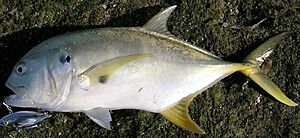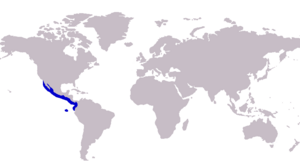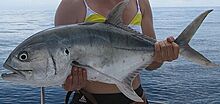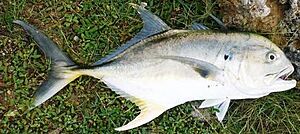Pacific crevalle jack facts for kids
Quick facts for kids Pacific crevalle jack |
|
|---|---|
 |
|
| Conservation status | |
| Scientific classification | |
 |
|
| Approximate range of the Pacific crevalle jack | |
| Synonyms | |
|
The Pacific crevalle jack (Caranx caninus) is a large ocean fish. It belongs to the jack family called Carangidae. This fish lives in the warm, tropical waters of the eastern Pacific Ocean. You can find it from California in the north all the way down to Peru in the south. It also lives around several islands far offshore.
This fish is easy to spot because of its deep body. It also has a chest that is mostly smooth, without scales. The Pacific crevalle jack can grow quite large. It can reach up to 101 cm (about 3.3 feet) long. It can also weigh up to 19.7 kg (about 43 pounds). For a long time, scientists argued if it was the same species as the Atlantic Caranx hippos (the crevalle jack). However, recent studies show it is its own unique species.
This fish usually swims in large groups, called schools, near the coast. They prefer sandy or rocky areas. But bigger fish sometimes swim in the open ocean, as deep as 350 meters. The Pacific crevalle jack is a fast predator. It eats many kinds of fish, crustaceans like crabs, and other small ocean creatures. They are thought to lay their eggs all year round. However, there are more eggs laid in November and May. This fish is important for people who fish for a living. In some parts of Mexico, it makes up a big part of the yearly catch. Anglers also like to catch them for sport. But many people think they don't taste very good.
Contents
What is a Pacific Crevalle Jack?
The Pacific crevalle jack is part of the Caranx genus. This group includes many fish known as jacks or trevallies. The Caranx genus is part of the larger Carangidae family. This family includes all the jacks and horse mackerels. Scientists group the Pacific crevalle jack with two similar species. These are the Crevalle jack (Caranx hippos) and the Longfin crevalle jack (Caranx fischeri).
How the Pacific Crevalle Jack Got Its Name
A British scientist named Albert C. L. G. Günther first described this fish in 1867. He found a specimen in Panama. He named it Caranx caninus. The name caninus means 'dog-like'. This is probably because of its strong teeth. For many years, people debated if it was a separate species. Some even called it a subspecies of the Atlantic crevalle jack. They used the name Caranx hippos caninus.
However, a recent study confirmed it is a separate species. Scientists found differences in how their bones grow. They also noticed different colors on their anal fins. These differences show they are not the same fish. People usually call it the 'Pacific crevalle jack'. This is because it looks a lot like the Atlantic 'crevalle jack'. It also has several Spanish names.
Where Do Pacific Crevalle Jacks Live?
The Pacific crevalle jack lives in the warm waters of the eastern Pacific Ocean. Its home stretches along the western coast of America. You can find it from Peru in the south up to San Diego Bay, California, in the north. It's not very common north of the Gulf of California. But during El Nino events, warm waters move north. This brings Pacific crevalle jacks and other fish further than usual.
This fish also lives around several islands far out in the Pacific. These include the Galápagos, Malpelo, Cocos, and Revillagigedo Islands.
Pacific Crevalle Jack Habitats
Pacific crevalle jacks are most often found near the coastal areas. But sometimes, they swim in the open ocean. They don't usually go deeper than 350 meters (about 1,150 feet). Near the coast, they like sandy and rocky bottoms. They also gather in protected bays, lagoons, and harbours. Here, they form large schools.
Older, bigger fish often swim alone. They tend to live in deeper, offshore waters. Young Pacific crevalle jacks are common in estuaries. These are places where rivers meet the sea. They can even swim far up into rivers. This shows they can live in water with different salt levels.
What Does a Pacific Crevalle Jack Look Like?
The Pacific crevalle jack is a fairly large fish. The biggest one ever recorded was 101.6 cm (about 40 inches) long. It weighed 19.7 kg (about 43 pounds). It looks like other jacks in the Caranx group. It has a body that is somewhat deep and flat from side to side. Its back is more curved than its belly.
The fish has two dorsal fins on its back. The first one has eight stiff spines. The second has one spine and 19 to 21 soft rays. Its anal fin on the belly has two separate spines in front. Then it has one spine and 16 to 17 soft rays. The pectoral fins are long and curved. The caudal fin (tail fin) is deeply forked.
The side of the fish has a special line called the lateral line. This line helps them sense movement in the water. The front part of this line is curved. It has 58 to 79 scales. The straight part has a few scales and 34 to 43 strong, bony plates called scutes. The chest of the fish has no scales. Only a small patch of scales is found in front of the pelvic fins.
The Pacific crevalle jack has good eyesight. It has well-developed adipose eyelids. Its teeth are also special. The upper jaw has an outer row of widely spaced canine teeth. It also has an inner band of small, brush-like teeth. The lower jaw has a row of widely spaced cone-shaped teeth.
Color and Markings
The Pacific crevalle jack is bluish-green to bluish-black on its back. Its belly is silvery white or golden. Young fish are usually lighter in color. They also have five dark stripes on their sides.
Most of its fins are white or dusky. But the anal fin and the lower part of the tail fin are white to brownish-orange. The underside of the tail stem is also this color. This is different from the Atlantic crevalle jack. That fish has bright yellow anal and lower tail fins. The Pacific crevalle jack also has a black spot at the base of its pectoral fins. There is also a dark blotch on the edge of its gill cover.
Pacific Crevalle Jack Life Cycle and Behavior
The Pacific crevalle jack often swims in schools. These groups can be medium to large in size. They can move very quickly through the water. Older fish tend to swim alone. They move to deeper waters offshore. This fish is one of the most common fish in its range. This makes it important for both the ocean's ecosystem and for fishing.
This species is a strong and fast predator. It mainly eats small fish. It also eats crustaceans like prawns. And it eats other small creatures that live on the ocean floor. Scientists haven't collected detailed information about their exact diet yet.
Reproduction and Growth
Male Pacific crevalle jacks start to reproduce when they are about 67 cm (26 inches) long. Females start when they are about 65 cm (25 inches) long. They are thought to lay eggs all year. But there are times when they lay more eggs. In Colombia, this happens in January-February and August. In Mexico, it's in May and November. The eggs float in the water. So do the newly hatched larvae (baby fish).
Scientists have studied how fast these fish grow. After one year, they are about 19 to 20 cm long. After two years, they are about 29 to 32 cm long. And after three years, they are about 36 to 42 cm long. Some studies suggest they can live for 12 to 15 years. One study even said they could live up to 37 years! Scientists can tell their age by looking at their otoliths. These are ear bones that have yearly growth rings.
The growth rings show that they grow faster from August to February. This is during the rainy season. More rain brings more nutrients to the coast. This helps them grow. They grow slower from March to August. Even though one of the main spawning times happens then.
Fishing for Pacific Crevalle Jacks
The Pacific crevalle jack is very important for fisheries in its habitat. There are many of these fish. This allows fishermen to catch a lot of them. In many Central American countries, fishing is done by small, local groups. So, detailed records of catches are not always kept. This makes it hard to know the total number caught each year.
However, where records are kept, it's clear this fish is very important. In Colima, Mexico, it makes up to 15% of the total yearly catch. This means about 76 tonnes (about 167,000 pounds) are caught each year in Colima alone. Fishermen catch them all year using different methods. These include trawling (dragging nets), fixed nets, and hook and line.
Angling for Sport

The Pacific crevalle jack is also a popular fish for anglers. Anglers can catch them using live bait. They also use different types of lures. These include surface poppers and fast-moving metal slugs or spoons. The IGFA (International Game Fish Association) keeps world records for this fish. The current world record for the biggest Pacific crevalle jack is 17.69 kg (39 lb). It was caught off Playa Zancudo, Costa Rica, in 1997.
How Pacific Crevalle Jacks Are Used
When caught, these fish are sold in different ways. They can be sold fresh or frozen. They are also smoked, salted, or dried. Sometimes, they are used to make fishmeal and oil. Even though many are caught, the Pacific crevalle jack is not considered a top-quality fish for eating. It usually sells for low prices at the market. How much it's valued can change depending on local opinions.
Most people think it's not the best fish to eat. But some say that if you bleed the fish right after catching it, the taste gets better.
Images for kids





